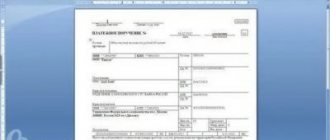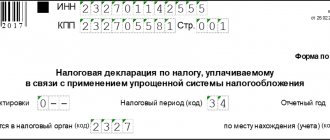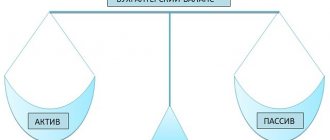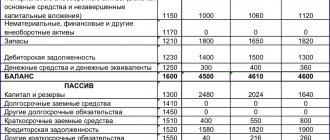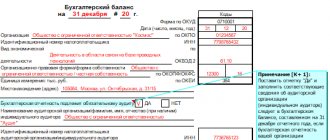What is a balance sheet and how to draw it up using a sample form? What form does the LLC's balance sheet have and what items does it contain? What are the stages of analyzing a company's balance sheet?
Dear friends, I, Alla Prosyukova, welcome you to the pages of the HeatherBober online magazine!
I suggest you read a new article about the procedure for drawing up the balance sheet of an enterprise.
I tried to explain the procedure for compiling a balance sheet as simply and clearly as possible using practical examples.
What is a balance sheet and why is it prepared?
Most Russian companies compile and present various accounting reports.
The main set of such reporting includes five forms:
- Form No. 1 - “Balance Sheet;
- Form No. 2 - “Report on financial results”;
- Form No. 3 - “Report on changes in capital”;
- Form No. 4 - “Cash Flow Statement”;
- Form No. 5 - “Appendix to the Balance Sheet”.
I propose to take a closer look at form No. 1 – balance sheet.
The balance sheet is information about the company’s property (assets) and the sources of its acquisition (liabilities), grouped as of the reporting date in the form of a table. An asset is always equal to a liability!
Let's get acquainted with the principles of drawing up a balance using the example of the budget of one Russian family.
Example
A large, friendly Pugovkin family lives in the city of N. The family is wealthy by city standards. They have: an apartment, a car, household appliances, furniture, clothes, food, a summer house. In addition, there is money in the wallets and bank accounts of family members.
In general, the Pugovkins have everything they need for a comfortable active life. These will be the assets of the Pugovkin family.
Take a sheet of blank paper and write all of the above in 2 columns.
Assets of the Pugovkin family:
| Article | Name | Cost, thousand rubles |
| 1 | Apartment | 4 000 |
| 2 | Country house | 1 000 |
| 3 | Car | 1 100 |
| 4 | Appliances | 300 |
| 5 | Products | 50 |
| 6 | Money in wallets | 30 |
| 7 | Money in the bank | 450 |
| 8 | Furniture | 610 |
| 9 | Cloth | 40 |
| 10 | Total | 7 580 |
To acquire all this, the family needed funds. Therefore, the Pugovkins took out a bank loan and borrowed part of the money from friends. In addition, the Pugovkin family currently has unpaid utilities and property taxes.
A bank loan, debt to friends, unpaid utility bills and taxes are the liabilities of the Pugovkin family.
Liabilities of the Pugovkin family:
| № | Name of liability | Cost, thousand rubles. |
| 1 | Bank loan | 6 184 |
| 2 | Debt to friends | 1 200 |
| 3 | Debt to utilities | 11 |
| 4 | Tax debt | 25 |
| 5 | Salary of family members | 160 |
| 6 | Total | 7 580 |
The assets and liabilities of the balance sheet are divided into several parts.
Asset sections:
- non-current assets;
- working capital.
Passive sections:
- capital and reserves;
- long term duties;
- Short-term liabilities.
The balance sheet is in demand by various users.
External users:
- tax authorities;
- banks;
- investors;
- partners (counterparties).
Internal users:
- shareholders of the company;
- planning and analytical department.
How to fill out a balance sheet using a balance sheet (SAS)
Published 03/12/2015 14:00 To be honest, I did not want to write an article on a similar topic, since if the program works correctly, this knowledge is not necessary, but nevertheless, I am periodically asked questions of this kind. Situations are different; sometimes you actually have to additionally check the reports filled out by the program if the accounting in it was not kept very carefully. Or maybe someone will be interested in understanding how the balance sheet is filled out from an accounting point of view, and keeping for themselves such a small reference book about what information on accounts should be included in it.
If you work in 1C programs, then before filling out the balance sheet in one way or another, you need to prepare the data stored in the program. I talked about how to do this in my article What needs to be done before filling out reports in 1C to avoid mistakes.
After this, you can try to automatically generate a balance. I looked at an example for the 1C program: Enterprise Accounting 8 edition 3.0 in the video tutorial How to fill out a balance sheet in 1C.
If for some reason automatic filling is not possible or you do not work in 1C, then we carefully study the balance sheet and begin filling out the report line by line (this article outlines the filling method implemented by specialists). A transcript with the names of the accounts used can be viewed at the link Chart of accounts ASSET Section I - Non-current assets Line 1110 (intangible assets) Balance at the end of the period on the debit of account 04.01 -minusBalance at the end of the period on the credit of account 05 +plusBalance at the end of the period on the debit of account 08.05
Line 1120 (results of research and development) Balance at the end of the period on the debit of account 04.02 + plus Balance at the end of the period on the debit of account 08.08
Line 1130 (intangible search assets) Balance at the end of the period on the debit of the account 08.11
Line 1140 (material search assets) Balance at the end of the period on the debit of account 08.12 Line 1150 (fixed assets) Balance at the end of the period on the debit of account 01 -minusBalance at the end of the period on the credit of account 02.01 +plusBalance at the end of the period on the debit of account 07 +plusBalance on end of the period by debit of accounts 08.01, 08.02, 08.03, 08.04
Line 1160 (income investments in material assets) Balance at the end of the period on the debit of account 03 - minus Balance at the end of the period on the credit of account 02.02
Line 1170 (financial investments) Balance at the end of the period on the debit of account 58.01.1
Line 1180 (deferred tax assets) Balance at the end of the period in the debit of account 09
Line 1190 (other non-current assets) Balance at the end of the period on the debit of account 08.06 +plusBalance at the end of the period on the credit of account 08.07 +plusBalance at the end of the period on the debit of account 97 (objects with the value of the attribute “Type of asset” - “Other non-current assets”)
Section II - Current assets Line 1210 (inventories) Balance at the end of the period on the debit of account 10 - minus Balance at the end of the period on the credit of account 14.01 + plus Balance at the end of the period on the debit of account 15.01 + plus Balance at the end of the period on the debit of account 16.01 - minus Balance at the end of the period on the credit of account 16.01 + plusBalance at the end of the period on the debit of account 11 + plusBalance at the end of the period on the debit of account 20 + plusBalance at the end of the period on the debit of account 21 + plusBalance at the end of the period on the debit of account 23 + plusBalance at the end of the period on the debit of account 29 + plusBalance at the end of the period on the debit of account 44 - minusBalance at the end of the period on the credit of account 14.04 + plusBalance at the end of the period on the debit of account 43 - minusBalance at the end of the period on the credit of account 14.03 + plusBalance at the end of the period on the debit of account 41 - minusBalance at the end of the period on account credit 14.02 + plusBalance at the end of the period on the debit of account 15.02 + plusBalance at the end of the period on the debit of account 16.02 - minusBalance at the end of the period on the credit of account 16.02 - minusBalance at the end of the period on the credit of account 42 + plusBalance at the end of the period on the debit of account 45 + plusBalance at the end of the period on the debit of account 28 + plusBalance at the end of the period on the debit of account 97 (objects with the value of the attribute “Type of asset” - “Inventories”) + plusBalance at the end of the period on the debit of account 76.01.2, expanded to the subaccount “Counterparties” (objects with the value of the attribute “Type of asset” - “Inventories”) + plusBalance at the end of the period on the debit of account 76.01.9, expanded to the subaccount “Counterparties” (objects with the value of the attribute “Type of asset” - “Inventories”)
Line 1220 (VAT on purchased assets) Balance at the end of the period in the debit of account 19 - minus Balance at the end of the period in the debit of account 19.06
Line 1230 (accounts receivable)
Balance at the end of the period on the debit of the account 60.02 + plus Negative balance at the end of the period on the credit of account 60.01, expanded by subaccount “Counterparties”, “Agreements” + plus Balance at the end of the period on the debit of the account 60.22 + plus Negative balance at the end of the period on the credit of the account 60.21, expanded under the sub-account “Counterparties”, “Agreements” + plus Balance at the end of the period on the debit side of the account 60.32 + plus Negative balance at the end of the period on the credit of the account 60.31, expanded under the sub-account “Counterparties”, “Agreements” - minus Balance at the end of the period on the credit of account 76.BA + plus Balance at the end of the period on the debit of account 62.03 + plus Balance at the end of the period on the debit of account 62.01, expanded by subaccount “Counterparties”, “Agreements” + plus Balance at the end of the period on the debit of account 62.21, expanded by subconto "Counterparties", "Agreements" + plus Balance at the end of the period on the debit of account 62.31, expanded on the subconto "Counterparties", "Agreements" - minus Balance at the end of the period on the credit of account 63 + plus Balance at the end of the period on the debit of account 68.01, expanded by subconto “Types of payments to the budget (funds)” + plus Balance at the end of the period in the debit of account 68.02, expanded by subconto “Types of payments to the budget (funds)” + plus Balance at the end of the period in the debit of account 68.03, expanded by subconto “ Types of payments to the budget (funds)" + plus Balance at the end of the period in the debit of account 68.04.1, expanded by subconto "Types of payments to the budget (funds)", "Budget levels" + plus Balance at the end of the period in the debit of account 68.04.2 + plus Balance at the end of the period in the debit of account 68.07, expanded under the sub-account “Types of payments to the budget (funds)” + plus Balance at the end of the period in the debit of account 68.08, expanded under the sub-account “Types of payments to the budget (funds)” + plus Balance on end of the period in the debit of account 68.09, expanded in the sub-account “Types of payments to the budget (funds)” + plus Balance at the end of the period in the debit of account 68.10, expanded in the sub-account “Types of payments in the budget (funds)”, “Budget levels” + plus Balance at the end of the period in the debit of account 68.11, expanded in the sub-account “Types of payments to the budget (funds)” + plus Balance at the end of the period in the debit of account 68.12, expanded in the sub-account “Types of payments in the budget (funds)” + plus Balance at the end of the period in debit of subaccounts of account 69 + plus Balance at the end of the period in the debit of account 70, expanded in the subaccount “Employees of the organization” + plus Balance at the end of the period in the debit of account 71, expanded in the subaccount “Employees of the organization” + plus Balance at the end of the period in the debit of account 73.01 + plus Balance at the end of the period in the debit of account 73.02 + plus Balance at the end of the period in the debit of account 73.03, expanded under the subaccount “Employees of the organization” + plus Balance at the end of the period in the debit of account 75.01 + plus Balance at the end of the period in the debit of account 76.01.1 , expanded under the sub-account “Counterparties” + plus Balance at the end of the period in the debit of the account 76.21, expanded in the sub-account “Counterparties” + plus Balance at the end of the period in the debit of the account 76.02 + plus Balance at the end of the period in the debit of the account 76.22 + plus Balance at the end of the period on the debit of account 76.32 + plus Balance at the end of the period on the debit of account 76.03, expanded on the subaccount “Counterparties” + plus Balance at the end of the period on the debit of account 76.05, expanded on the subaccount “Counterparties” + plus Balance at the end of the period on the debit of account 76.25, expanded on the sub-account “Counterparties” + plus Balance at the end of the period in the debit of account 76.35, expanded in the sub-account “Counterparties” + plus Balance at the end of the period in the debit of account 76.09, expanded in the sub-account “Counterparties” + plus Balance at the end of the period in the debit of account 76.29, expanded by the sub-account “Counterparties” + plus Balance at the end of the period in the debit of the account 76.39, expanded in the sub-account “Counterparties” + plus Balance at the end of the period in the debit of the account 76.41, expanded in the sub-account “Counterparties” + plus Balance at the end of the period in the debit of the account 76.06 , expanded under the sub-account “Counterparties” + plus Balance at the end of the period in the debit of the account 76.26, expanded in the sub-account “Counterparties” + plus Balance at the end of the period in the debit of the account 76.36, expanded in the sub-account “Counterparties” + plus Balance at the end of the period in the debit of the account 76.K, expanded by subaccount “Counterparties” + plus Balance at the end of the period in the debit of account 97 (objects with the value of the attribute “Type of asset” - “Accounts receivable”) + plus Balance at the end of the period in the debit of account 76.01.2, expanded by subconto "Counterparties" (objects with the value of the attribute "Type of asset" - "Accounts receivable") + plus Balance at the end of the period on the debit of account 76.01.9, expanded under the subconto "Counterparties" (objects with the value of the attribute "Type of asset" - "Receivable debt") + plus Balance at the end of the period in the debit of account 46 + plus Balance at the end of the period in the debit of account 96 Line 1240 (financial investments (except for cash equivalents)) Balance at the end of the period in the debit of account 58.01.2 + plus Balance at the end of the period on the debit of account 58.02 - minusBalance at the end of the period on the credit of account 59 + plusBalance at the end of the period on the debit of account 58.03 + plusBalance at the end of the period on the debit of account 58.04 + plusBalance at the end of the period on the debit of account 58.05 + plusBalance at the end of the period on the debit of account 55.03 + plusBalance at the end of the period on the debit of the account 55.23
Line 1250 (cash and cash equivalents)
Balance at the end of the period on the debit account 50.01 + plus Balance at the end of the period on the debit account 50.02 + plus Balance at the end of the period on the debit account 50.21 + plus Balance at the end of the period on the debit account 50.04 + plus Balance at the end of the period on the debit account 51 + plus Balance at the end of the period on the debit account 52 + plus Balance at the end of the period on the debit account 55.01 + plus Balance at the end of the period on the debit account 55.02 + plus Balance at the end of the period on the debit account 55.04 + plus Balance at the end of the period on the debit account 55.21 + plus Balance at the end of the period in the debit of account 55.24 + plus Balance at the end of the period in the debit of account 57 Line 1260 (other current assets)
Balance at the end of the period on the debit account 19.06 + plus Balance at the end of the period on the debit account 50.03 + plus Balance at the end of the period on the debit account 50.23 + plus Balance at the end of the period on the debit account 68.22 + plus Balance at the end of the period on the debit account 76.OT + plus Balance at the end of the period in the debit of account 76.NA + plus Balance at the end of the period in the debit of account 97 (objects with the value of the attribute “Type of asset” - “Other current assets”) + plus Balance at the end of the period in the debit of account 76.01.2 , expanded under the sub-account “Counterparties” (objects with the value of the attribute “Type of asset” - “Other current assets”) + plus Balance at the end of the period in the debit of account 76.01.9, expanded under the sub-account “Counterparties” (objects with the value of the attribute “Type of asset” " - "Other current assets") + plus Balance at the end of the period in the debit of account 94
LIABILITY Section III - Capital and reserves Line 1310 (authorized capital) Balance at the end of the period on the credit of account 80 Line 1320 (own shares purchased from shareholders) Balance at the end of the period on the debit of account 81 Line 1340 (revaluation of non-current assets) Balance at the end of the period on the credit of account 83.01 Line 1350 (additional capital) Balance at the end of the period on the credit of account 83 - minus Balance at the end of the period on the credit of account 83.01
Line 1360 (reserve capital) Balance at the end of the period on the credit of account 82 Line 1370 (retained earnings (uncovered loss)) Balance at the end of the period on the credit of account 84 - minus Balance at the end of the period on the debit of account 84 + plus Balance at the end of the period on the credit of account 99 — minus Balance at the end of the period on the debit of account 99
Section IV - Long-term liabilities Line 1410 (borrowed funds) Balance at the end of the period on the credit of account 67.01 + plus Balance at the end of the period on the credit of account 67.21 + plus Balance at the end of the period on the credit of account 67.03 + plus Balance at the end of the period on the credit of account 67.23
Line 1420 (deferred tax liabilities) Balance at the end of the period on the credit of account 77 Section V - Current liabilities Line 1510 (borrowed funds) Balance at the end of the period on the credit of account 66 + plus Balance at the end of the period on the credit of account 67.02 + plus Balance at the end of the period on the loan account 67.04 + plusBalance at the end of the period on the account credit 67.22 + plusBalance at the end of the period on the account credit 67.24
Line 1520 (Accounts payable)
Balance at the end of the period on the credit of account 60.01, expanded under the subaccount “Counterparties”, “Agreements” + plus Balance at the end of the period on the credit of account 60.21, expanded on the subaccount “Counterparties”, “Agreements” + plus Balance at the end of the period on the credit of account 60.31 , expanded under the subconto “Counterparties”, “Agreements” + plus Balance at the end of the period on the credit of account 60.03 + plus Balance at the end of the period on the credit of account 62.02 + plus Negative balance at the end of the period on the debit of account 62.01, expanded on the subconto “Counterparties”, “Contracts” + plus Balance at the end of the period on the credit of account 62.22 + plus Negative balance at the end of the period on the debit of account 62.21, expanded under the subaccount “Counterparties”, “Contracts” + plus Balance at the end of the period on the credit of account 62.32 + plus Negative balance on end of the period in the debit of account 62.31, expanded in the sub-account “Counterparties”, “Agreements” - minus Balance at the end of the period in the debit of account 76.AB + plus Balance at the end of the period in the credit of account 68.01, expanded in the sub-account “Types of payments to the budget (funds) )" + plus Balance at the end of the period on the credit of account 68.02, expanded under the subconto "Types of payments to the budget (funds)" + plus Balance at the end of the period on the credit of account 68.03, expanded on the subconto "Types of payments to the budget (funds)" + plus Balance at the end of the period on the credit of account 68.04.1, expanded by subaccount “Types of payments to the budget (funds)”, “Budget levels” + plus Balance at the end of the period on the credit of account 68.04.2 + plus Balance at the end of the period on the credit of account 68.07 , expanded by subconto “Types of payments to the budget (funds)” + plus Balance at the end of the period on the credit of account 68.08, expanded by subconto “Types of payments to the budget (funds)” + plus Balance at the end of the period on the credit of account 68.09, expanded by subconto “Types of payments to the budget (funds)” + plus Balance at the end of the period on the credit of account 68.10, expanded by subconto “Types of payments to the budget (funds)”, “Budget levels” + plus Balance at the end of the period on the credit of account 68.11, expanded by subconto “Types of payments to the budget (funds)” + plus Balance at the end of the period on the credit of account 68.12, expanded under the subconto “Types of payments to the budget (funds)” + plus Balance at the end of the period on the credit of account 68.32 + plus Balance at the end of the period on credit of subaccounts of account 69 + plus Balance at the end of the period on the credit of account 70, expanded under the subaccount “Employees of the organization” + plus Balance at the end of the period on the credit of account 71, expanded on the subaccount “Employees of the organization” + plus Balance at the end of the period on the credit of account 73.03 , expanded under the sub-account “Employees of the organization” + plus Balance at the end of the period under the credit of account 75.02 + plus Balance at the end of the period under the credit of account 76.05, expanded under the sub-account “Counterparties” + plus Balance at the end of the period under the credit of account 76.25, expanded under the sub-account “ Counterparties" + plus Balance at the end of the period under the credit of account 76.35, expanded under the sub-account "Counterparties" + plus Balance at the end of the period under the credit of account 76.06, expanded under the sub-account "Counterparties" + plus Balance at the end of the period under the credit of account 76.26, expanded under the sub-account “Counterparties” + plus Balance at the end of the period under the credit of account 76.36, expanded under the sub-account “Counterparties” + plus Balance at the end of the period under the credit of account 76.01, expanded under the sub-account “Counterparties” + plus Balance at the end of the period under the credit of account 76.21, expanded under subconto "Counterparties" + plus Balance at the end of the period on the credit of account 76.03, expanded on the subconto "Counterparties" + plus Balance at the end of the period on the credit of account 76.04 + plus Balance at the end of the period on the credit of account 76.09, expanded on the subconto "Counterparties" + plus Balance at the end of the period on the credit of account 76.29, expanded under the sub-account “Counterparties” + plus Balance at the end of the period on the credit of account 76.39, expanded on the sub-account “Counterparties” + plus Balance at the end of the period on the credit of account 76.41, expanded on the sub-account “Counterparties” + plus Balance at the end of the period on the credit of account 76.K, expanded under the subaccount “Counterparties” + plus Balance at the end of the period on the credit of account 76.N
Line 1530 (deferred income) Balance at the end of the period on the credit of account 86 + plus Balance at the end of the period on the credit of account 98
Line 1540 (estimated liabilities) Balance at the end of the period on the credit of account 96 Line 1550 (other liabilities) Balance at the end of the period on the credit of account 76.NA
If you need more information about working in 1C: Enterprise Accounting 8, then you can get our book for free using the link.
Author of the article: Olga Shulova
Let's be friends on Facebook
Did you like the article? Subscribe to the newsletter for new materials
Add a comment
Comments
+10 Ekaterina Lebedeva 05.25.2017 15:03 Olga, good afternoon! Is it possible to post a similar algorithm for the profit and loss report?
Quote
+1 Olga Shulova 03/16/2016 16:07 I quote Lyudmila:
Good afternoon, Olga, we have in our balance sheet for 2014. in lines 1230 and 1520, the account 76.05 is taken in the “Counterparties” section. And we are creating a balance sheet for 2015. 76.05 the account is taken in the context of “Counterparties”, “Agreements”. And there is a divergence from last year
Hello, Lyudmila!
Yes, such a change in filling out the balance has occurred. Representatives of 1C say that the expanded balance in terms of contracts is a methodologically correct option, so this algorithm has now been adopted. All that remains is to manually adjust the indicators of previous years so that the data converges. Quote 0 Lyudmila 03/15/2016 12:56 I forgot to write that we work in Enterprise Accounting 3.0 (1C: Enterprise)
Quote
0 Lyudmila 03/15/2016 12:43 Good afternoon, Olga, we have in our balance sheet for 2014. in lines 1230 and 1520, the account 76.05 is taken in the “Counterparties” section. And we are creating a balance sheet for 2015. 76.05 the account is taken in the context of “Counterparties”, “Agreements”. And there is a divergence from last year
Quote
0 Yukon 01/28/2016 23:03 Thank you very much for a job well done and a very useful article! Very interesting site!!!
Quote
+5 Alina 10/07/2015 15:05 Thank you very much for such an article! Very useful!!
Quote
+2 Olga Shulova 08/03/2015 14:46 I quote Mikhail Volkov:
Line 1250 (cash and cash equivalents) Balance at the end of the period in the debit of the account 50.01 + plus Balance at the end of the period in the debit of the account 50.02 + plus Balance at the end of the period in the debit of the account 50.21 + plus Balance at the end of the period in the debit of 50.04 + plus... . Why is 50.03 missing?
Hello!
The balance on account 50.03 is taken into account as part of other current assets (Line 1260) Quote 0 Mikhail Volkov 08/03/2015 12:55 Line 1250 (cash and cash equivalents) Balance at the end of the period in the debit of account 50.01 + plus Balance at the end of the period in the debit of the account 50.02 + plus Balance at the end of the period in the debit of the account 50.21 + plus Balance at the end of the period in the debit of the account 50.04 + plus…. Why is 50.03 missing?
Quote
+10 Elena 03/18/2015 10:52 Oh, where was this article when I was in college? We ourselves developed such formulas based on SALT. Thanks a lot! Very useful article!
Quote
Update list of comments
JComments
How to draw up a balance sheet - step-by-step instructions for beginners
The process of preparing a balance sheet is very complicated, not only for beginners. Some aspects of its preparation may cause difficulties for professional accountants.
I propose to consider with me step by step its main points.
Step 1. Specify the details
As a rule, filling out any reporting form begins with the title page. The balance sheet is no exception. To fill it out, a unified form approved by the Ministry of Finance is used.
The first sheet contains the details of the company making up the balance sheet:
- the date on which the form is drawn up;
- Date of preparation;
- Company name;
- an identification number;
- type of economic activity;
- type of ownership;
- unit of measurement;
- location of the company.
Step 2. Fill in the rows of the asset table
The next step is to fill out the asset balance sheet. We take all the information from the balances of the company’s accounts (we use the balance sheet (SAS)).
Example
For Pomidorka LLC, 2021 is the first period when the company needs to report, because it was in this year that the company was created. Let's present the balances according to accounting data in the form of a table.
Balances of Pomidorka LLC as of 01/01/2017:
| № | Name | Check | Debit | Credit |
| 1 | Fixed Assets (Fixed Assets) | 01 | 500 | |
| 2 | Depreciation of fixed assets | 02 | 26 | |
| 3 | Intangible assets (IMA) | 04 | 100 | |
| 4 | Depreciation of intangible assets | 05 | 4 | |
| 5 | Reserves | 10 | 460 | |
| 6 | VAT | 19 | 16 | |
| 7 | Money in the cash register | 50 | 40 | |
| 8 | Funds in bank account | 51 | 120 | |
| 9 | Authorized capital | 80 | 30 | |
| 10 | Reserve capital | 82 | 10 | |
| 11 | retained earnings | 84 | 150 | |
| 12 | Settlements with suppliers and contractors | 60 | 275 | |
| 13 | Settlements with buyers and customers | 62 | 85 | |
| 14 | Calculations for long-term loans and borrowings | 67 | 300 | |
| 15 | Calculations for taxes and fees | 68 | 16 | |
| 16 | Social insurance calculations | 69 | 90 | |
| 17 | Payroll calculations | 70 | 250 | |
| 18 | Total | 1236 | 1236 |
When drawing up a balance sheet, remember that:
- debit and credit balances in the balance sheet are not collapsed;
- Fixed assets and intangible assets are shown at residual value;
- assets in the balance sheet are reflected at book value.
Information in the balance sheet is divided item by item (approved by the Ministry of Finance). Opposite each item is the amount taken from the SALT on the reporting date; in 2 adjacent columns the itemized value of the property for the two previous reporting dates is indicated.
Continuation of the example
Based on the accounting data of Pomidorka LLC, we will compile a part of the balance sheet called “Asset”.
Active:
| Index | Calculation | Code | as of 12/31/2016 | as of 12/31/2015 |
| ASSETS | ||||
| I. Non-current assets | ||||
| NMA | sch04-05 | 1110 | 96 | — |
| OS | sch01-02 | 1150 | 474 | — |
| Summary of Section I | 1110+1150 | 1100 | 570 | — |
| II. Current assets | ||||
| Reserves | sch10 | 1210 | 460 | — |
| VAT on purchased material assets | sch19 | 1220 | 16 | — |
| Cash and cash equivalents | sch50+51 | 1250 | 160 | — |
| Summary of Section II | 1210+1220+1250 | 1200 | 636 | |
| BALANCE | 1100+1200 | 1600 | 1206 | |
Information is indicated in whole thousands or millions of rubles. Blank rows are not included in the table. In a real balance sheet, all lines must be present; they are simply marked with a dash.
Step 3. Fill in the rows of the liability table
We do the same when filling out the “Passive” section. Let's take a closer look at the example of Pomidorka LLC.
Example
Filling out the “Passive” section:
| Index | Calculation | Code | as of 12/31/2016 | as of 12/31/2015 |
| PASSIVE | ||||
| III. Capital and reserves | ||||
| Authorized capital | count 80 | 1310 | 30 | — |
| Reserve capital | count 82 | 1360 | 10 | — |
| retained earnings | count 84 | 1370 | 150 | — |
| Summary of Section III | 1310+1360+1370 | 1300 | 190 | |
| IV. long term duties | ||||
| Borrowed funds | count 67 | 1410 | 300 | — |
| Summary of Section IV | 1410 | 1400 | 300 | — |
| V. Current liabilities | ||||
| Accounts payable | count 60+62+68+69+70 | 1520 | 716 | — |
| Summary of Section V | 1520 | 1500 | 716 | — |
| BALANCE | 1300+1400+1500 | 1700 | 1206 | — |
Step 4. Compare table values
Do you remember that asset = liability? In the balance sheet, line 1600 and line 1700 have the same figure of 1206 thousand rubles. This indicates that the form is drawn up correctly.
If there are discrepancies in these lines, it means that an error has crept into the accounting, which must be found.
Let me tell you right away, this is not an easy task. First, I recommend checking the arithmetic calculations. If there are no problems with arithmetic, proceed to checking the accounting entries in OSV.
Step 5. We analyze the balance sheet according to its indicators
Analysis of the balance sheet and its indicators is a complex, multi-stage process. I told you how to do it above. The results of the analysis help optimize the financial policy of the company. A high-quality analysis allows you to make competent management decisions.
Balance Reformation
The balance sheet is reformed in the program through a regulatory operation of the same name when closing the month (Operations – Closing the month).
The balance sheet is reformed on December 31 after the completion of the recording of all transactions in the reporting year. Accounts 90 “Sales” and 91 “Other income and expenses” are closed to subaccounts 90.09 and 91.09, respectively. After this, the financial result for the year is reflected as part of retained earnings (uncovered loss) on account 99 “Profit and losses”. The “Balance Reformation” operation is available only at the end of the month December.
To check the correctness of the balance sheet reformation, we will create a Turnover Balance Sheet for December of the reporting year and make sure that accounts 90, 91 and 99 do not have a closing balance (Reports – Turnover Balance Sheet).
Who provides balance sheet services - review of the TOP 3 companies
Accounting services, including services for preparing balance sheets, are offered by many companies.
By tradition, I have prepared for you, my readers, a selection of reliable, highly professional accounting firms.
1) My business
Internet accounting “My Business”, despite its young age (founded in 2009), has earned well-deserved respect from more than 50,000 users in all Russian regions.
Users note a number of advantages that they have and which predetermined the choice of this company.
Advantages of online accounting “My Business”:
- affordable prices (subscription fee from 366 to 2083 rubles per month);
- friendly, fast and professional support;
- wide range of services and opportunities;
- clear educational materials that can turn a beginner into a professional;
- the ability to register your business online;
- a large database of ready-made document templates for most business processes;
- accountant's bureau, consisting of 17 sections with answers to more than 10 thousand user questions.
If you are still hesitating, then visit the “My Business” website, read reviews from real users, and learn more about the functionality of this service.
A pleasant bonus for new users will be the opportunity to use online accounting services for free for a month.
2) Project-KM
The Moscow company Project-KM has been providing professional accounting services to legal entities, individual entrepreneurs and individuals for more than 9 years.
For the company's staff of highly qualified specialists, it will not be difficult to:
- formulate an Accounting Policy;
- organize accounting of any complexity;
- carry out full or partial restoration of accounting;
- carry out tax accounting;
- organize effective management accounting.
A potential client can receive an initial consultation by visiting the Project-KM office, calling the company, or consulting online on the website.
In addition, on the Project-KM website you can fill out an online form for a preliminary calculation of the cost of services, order services and pay for them.
3) Abacus BC
Abak BC is an accounting company that employs professional accountants with more than 16 years of experience. The company has successfully passed more than 500 tax audits.
Company Services:
- calculation of financial results, taxes and fees of the customer’s company;
- conducting banking and cash transactions;
- preparation and submission of reports;
- personnel records management and organization of settlements with personnel.
Abak BC clients receive a number of benefits from cooperation:
- savings on paying for a full-time accountant;
- 24-hour consulting professional support;
- complete confidentiality.
If you transfer the accounting of your company to the specialists of Abak BK, the savings on accounting costs will be about 32%. This result is achieved due to the fact that the customer pays only for the work actually performed.
